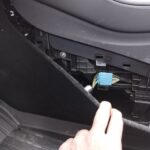Dealing with car troubles can be frustrating, especially when the check engine light pops on. Often, this warning light is triggered by a malfunctioning OBD2 sensor. These sensors are crucial components of your vehicle’s onboard diagnostic system, monitoring everything from emissions to engine performance. When an OBD2 sensor is not working correctly, it can lead to inaccurate readings, performance issues, and of course, that dreaded check engine light. Fortunately, diagnosing these problems has become significantly easier and more accessible with user-friendly OBD2 tools.
For those who prefer a convenient and cost-effective approach, especially if you are an Android user, there are excellent options available right at your fingertips. One such tool is ForScan, an application available on the Google Play Store. For a nominal fee, ForScan allows you to read ABS codes, which can be incredibly helpful in pinpointing sensor-related issues. To use ForScan, you’ll need a Bluetooth OBD2 connector. It’s important to note that not all Bluetooth OBD2 connectors are created equal; some may not fully support the communication protocols needed for your vehicle. However, the BAFX Products Bluetooth OBD2 scan tool is a reliable option that is confirmed to work effectively.
Beyond basic diagnostics, you can also enhance your monitoring capabilities with TorquePro, another Android application, available for around $30. TorquePro provides access to a wide range of PIDs (Parameter IDs), allowing you to create custom gauges on your Android device. This means you can monitor crucial parameters like transmission temperature, boost pressure, and many other engine and vehicle metrics in real-time while driving. This eliminates the need for installing numerous physical gauges in your car’s interior. While you might still require dedicated gauges for specific readings like exhaust gas temperature (EGT) and fuel pressure, TorquePro covers a vast majority of the parameters that car enthusiasts and DIY mechanics commonly want to observe.
While professional-grade tools like AutoEnginuity offer comprehensive diagnostic capabilities, the convenience of using Android-based tools is undeniable. Having your smartphone readily available makes it significantly quicker and easier to check codes or monitor sensor data compared to fetching a laptop for the same tasks. For everyday diagnostics and monitoring, the Android-based solutions provide a compelling balance of functionality and convenience.
Regardless of the OBD2 tool you choose, remember a crucial safety tip: always pull and clear codes with the engine turned off. Attempting to do so with the engine running can sometimes cause the engine to stall. This is likely due to the tool attempting to access the Vehicle Identification Number (VIN) using a PID that is not supported while the engine is running, potentially causing communication issues and engine shutdown. By following this simple precaution, you can ensure a smoother and safer diagnostic process when dealing with a potentially “Obd2 Sensor Not Working”.
